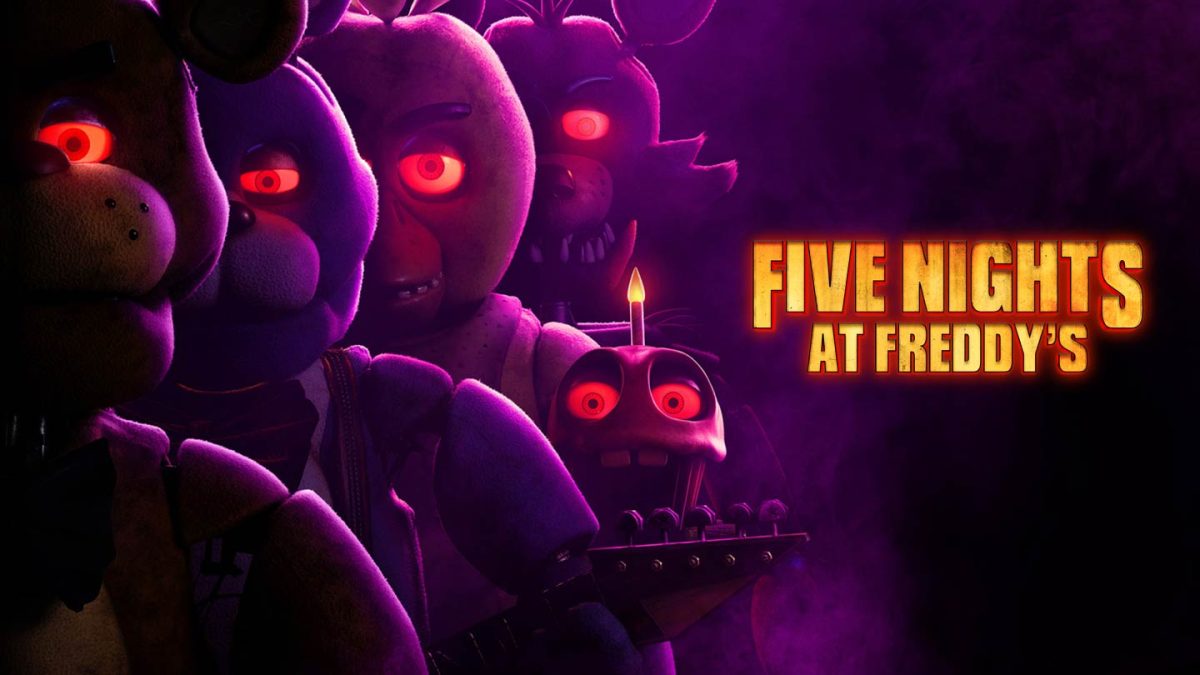Editors’ Note: Although the following review concerns a work of PG-13 fiction, some content may not be suitable for younger or more sensitive readers.
On August 8, 2014, indie game developer Scott Cawthon released a horror game known as Five Nights at Freddy’s, which would go on to spawn one of the most successful indie game franchises ever. Now, over nine years later, that same experience has been adapted to the big screen.
Personally, I have only recently gotten into the massive franchise that is Five Nights at Freddy’s (or FNAF). I was very surprised to see that the fascination many in the FNAF community shared was not with the tension, creepy atmosphere, or jumpscares of the game, but rather the complex lore that is hidden throughout each game. While I am not even close to understanding the full storyline, what I did understand helped shape my perspective on what to expect from the FNAF Movie.
But the moment the movie ended, I was left baffled, yet oddly satisfied.
The story follows Mike Schmidt (played by Josh Hutcherson), a young man struggling to make ends meet and take care of his younger sister, Abby (played by Piper Rubio), who seems more invested in her drawings than in wanting to talk to Mike or anyone else. In the midst of a custody battle between him and his aunt over Abby, Mike finds himself desperately in need of a job. He ends up taking up an old offer from his career counselor, Steve Raglan (played by Matthew Lilard). Mike finds himself as the nighttime security guard at the rundown Freddy Fazbear’s Pizza.
Unbeknownst to Mike, Freddy’s has become notorious for its tragic history, with five kids going missing at the location in the 80s. However, also hidden from Mike is the fact that the ghosts of the children now reside within the animatronic characters, Freddy Fazbear, Bonnie the Bunny, Chica the Chicken, and Foxy the Pirate.
Running parallel to the horrors of Freddy’s is Mike’s own painful history. When he was 12 years old, his brother was kidnapped by the same man who killed the five kids at Freddy’s, although Mike doesn’t find this out until much later. As a result, Mike has dedicated his life to finding the man who took his brother.
Mike goes as far as to take sleeping pills in order to relive the memory of losing his brother in his dreams, trying to memorize every detail in his dream in order to gain more clues about the identity of his brother’s kidnapper. But when Mike starts working as a night guard at Freddy’s, the spirits of the dead children also start appearing in his dreams. Later, Mike discovers that the connection he has with the children is also shared with Abby, providing Mike with an opening to figuring out who his brother’s kidnapper is.
This barely scratches the surface of the complex storyline of the movie, an aspect that may be challenging for many non-FNAF fans. However, in the context of the games, a lot of the weirdness present in the movies makes a lot of sense.
FNAF has always been more about solving the mystery of each game rather than simply getting a good scare. The lore of the games is often hidden in code–figuratively and sometimes literally–and half the fun of the games is trying to decipher what all the clues are actually leading to. Some end up leading to some crazy conclusions, which oftentimes don’t seem to make a lot of sense. However, the confusing nature of certain conclusions in one game are almost always clarified in the next, something that I believe will be paralleled in the movies; it’s safe to say that fans can expect a sequel coming in the near future.
But even as a standalone movie, it should be viewed less as a horror film and more as a murder mystery. Through that lens, the movie does a good job keeping audiences on their toes while also giving them lots to chew on after watching. Mystery is the film’s strongest suit, and it shows in the way some of the characters are presented.
A major supporting character in the film is Vanessa (played by Elizabeth Lail), a police officer who knows a lot more about Freddy’s than she initially lets on. By the end of the film, she reveals to Mike that she is the daughter of the murderer, William Afton, which only leaves the audience with more questions about her history and her connection to Freddy’s.
Afton himself is beautifully portrayed as a truly menacing threat. His identity is teased at the very beginning of the movie, which shows an 8-bit animation of a Golden Bonnie mascot luring kids to their demise. At the end of the film, Afton reveals himself to Mike, dressed in the Golden Bonnie suit. Despite receiving very little screen time, his performance as a deranged villain is one of the highlights of a film.
Finally, rounding out the list of perplexing characters is the supernatural Golden Freddy–the mysterious fifth murder victim who manifests himself as a golden phantom of Freddy Fazbear. Little is known about this character, but it is likely that, unlike the rest of the animatronics who are under Afton’s control for most of the film, Golden Freddy operates independently with his own ambitions. His interactions with both Mike and Abby make for some of the creepiest and intimidating interactions of the entire film.
Beyond the characters, the film also does a good job in its presentation of the mystery behind the Freddy’s restaurant. For many FNAF fans, many aspects of the plot points in the games have been altered in this film, with much to be left ambiguous about the history of the the restaurant. In this film, it is entirely possible that the Freddy’s location we see is a standalone location, while in the games, it is only one of a whole chain of sister locations. For newer fans, the empty, yet eerie atmosphere of Mike’s first night is enough to trigger both tension and speculation, even without the context of the convoluted lore of the games.
Additionally, the visual aspects of the film cannot be understated. The design of the pizzeria is unique while still remaining faithful to the game. The animatronics are spot-on, with all of them matching their in-game counterparts nearly flawlessly.
Finally, the cameos and appearances of various popular content creators cannot be ignored. YouTuber CoryxKenshin plays a taxi driver, and YouTuber and longtime FNAF theorist Matthew Patrick (or MatPat from The Game Theorists) appears as a waiter. Director Emma Tammi’s decision to feature these creators is a delight to longtime FNAF enthusiasts. Although I was never that interested in FNAF when it was in its infancy, MatPat’s videos have given me a solid understanding of the lore so far, so I was more than happy to see him on screen.
My major concern with the movie is that I only really understood it because I also taught myself to understand the complexity and weirdness that is the universe of FNAF. For others who are not as well versed in the franchise, the film will probably be difficult to follow at times.
Moreover, while I was pleasantly surprised by the fact that the story was more of a character-driven murder mystery than a traditional horror film, I did feel a bit dissatisfied because, by the second half of the movie, much of the horror is alleviated when Abby is seen befriending the animatronics. Thankfully, Golden Freddy appears not long afterwards to shift the tone once again, but even then, many of the animatronics just don’t seem all that threatening anymore.
Finally, while it is true that sometimes the story has to take center stage, fans may be disappointed that they do not get to see a full night that emulates the experience of the games. If there had been a scene with Mike frantically trying to stop the animatronics from entering the office–checking the cameras, closing the doors, etc.–just like in the first FNAF game, that would have served as a satisfying callback to many fans.
Overall, Five Nights At Freddy’s is a wonderful homage to FNAF fans and a solid, albeit complex, film for newcomers to enjoy.



